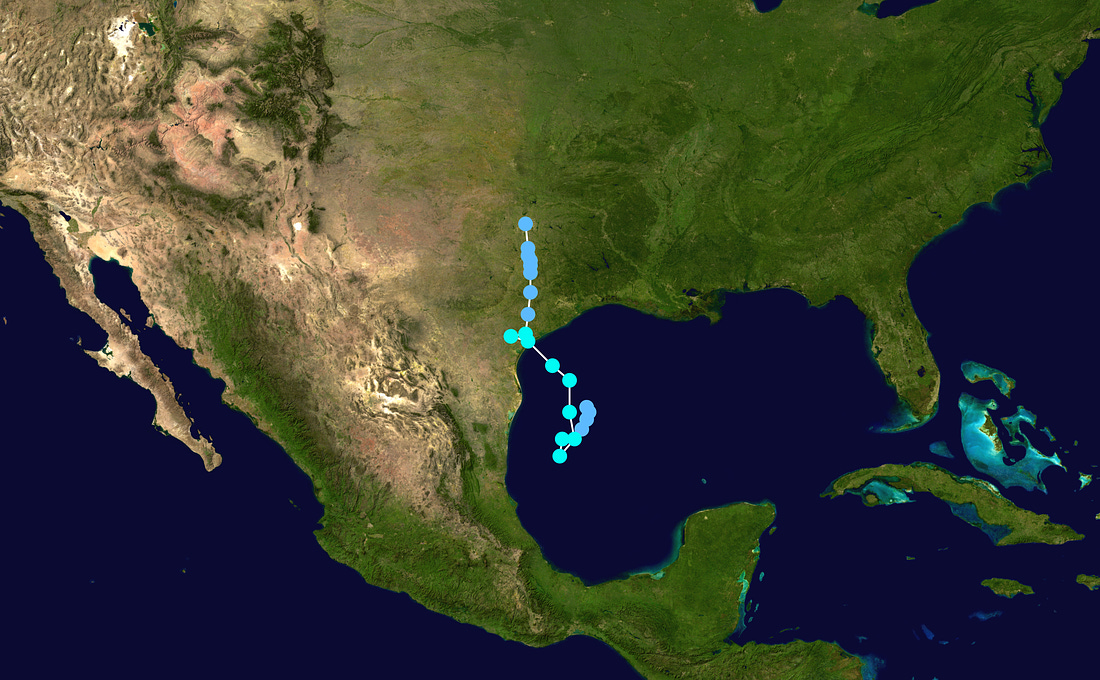From Doomberg at substack, December 17:
“The reactions of organic magnesium compounds are of two kinds – reactions of substitution and reactions of addition.” – Victor Grignard
On September 8, 1998, a tropical depression formed over the Western Gulf of Mexico that eventually became Tropical Storm Frances. Three days later, it made landfall just north of Corpus Christi and left significant flood damage in its wake, especially to the east which took the brunt of the storm surge and rainfall. Brazoria County, home to several critically important petrochemical complexes, received anywhere from 8-16 inches of rain.
Path of Tropical Storm Frances | Photo source: Wikipedia
Although Frances was undoubtedly a powerful rainmaker, from a meteorological perspective there wasn’t much about the storm that made it historically significant – certainly not compared to Hurricanes Katrina and Rita or Tropical Storm Harvey. Our interest in the event stems from the fact that you can trace the terminal decline of America’s leadership in – and China’s subsequent domination of – magnesium production to the fallout from Frances. Magnesium is yet another critical-to-the-global-economy input that is no longer within the West’s control.
For the better part of 80 years, Dow Chemical was the world’s primary producer of magnesium. Its sprawling petrochemical facility in Freeport, Texas was constructed as part of America’s manufacturing ramp-up during World War II. Because magnesium can be converted into strong-but-lightweight alloys, it was put to good use in the production of military aircraft. In support of the Allied war effort, Dow built a huge magnesium plant within its Freeport site, using seawater and electricity to make the metal in purified form.
Making magnesium from seawater is incredibly energy intense and creates significant environmental challenges. Already struggling with poor profitability, growing competition, and significant reinvestment needs, flood damage from Tropical Storm Frances was the final straw for Dow. The company initially declared force majeure in the aftermath of the storm and exited the magnesium business entirely a few months later.
In the years immediately prior to Dow’s exit in 1998, the US produced about half of the world’s magnesium. Today, the one remaining plant in the country is operated by US Magnesium, LLC near Salt Lake City, Utah, and captures only ~5% global market share. That facility has long been a key target for shutdown by environmentalists because of its worker safety and pollution issues. Earlier this year, the company entered into a comprehensive settlement with the EPA in an effort to resolve alleged illegal disposal of hazardous waste:
“The U.S. Environmental Protection Agency (EPA) and the U.S. Department of Justice (DOJ) today announced a settlement with U.S Magnesium (USM) to resolve violations of the Resource Conservation and Recovery Act (RCRA) and require response actions under the Comprehensive Environmental Response, Compensation and Liability Act (CERCLA) at its Rowley, Utah facility. The settlement includes extensive process modifications at the facility that will reduce the environmental impacts from its production operations and will ensure greater protection for its workers.”
*****
Ironically, Dow’s exit from the magnesium market began just as demand for the metal started to skyrocket. One of the main uses for magnesium is in the production of aluminum alloys, a strong and lightweight material that has allowed automakers to meet ever-increasing fuel economy standards. By replacing parts traditionally made with steel, automakers have shed hundreds of pounds from passenger vehicles with no meaningful sacrifice to structural integrity. When it comes to fuel economy, every pound counts, and aluminum alloys appear in many components of modern cars, including body panels, gearboxes, cargo beds, and seat frames....
....MUCH MORE
